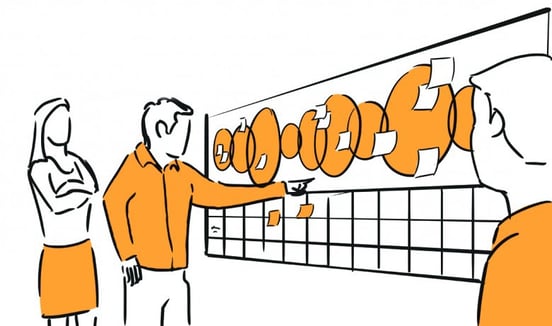
Experience mapping, a collaborative visioning method, is popular among design strategists complete with its own hashtag, #xmapping. Collaboratively mapping an experience with multiple stakeholders exposes parts of the overall experience that are difficult to predict and articulate. Engaging users and business teams in hands-on activities simultaneously to create a journey map is powerfully strategic and worth exploring.
1. Experience mapping: It’s a process, not just an artifact
Instead of just a team of designers envisioning an experience from an inside-out point of view, experience mapping brings consumers and business stakeholders together in one room. The goal is to incorporate multiple perspectives and map experiences holistically. The resulting map-artifact is very useful, but the experience of making is the truly valuable part of this method. Stakeholders work together to spatially map the different stages of the experience. In doing so, business and design teams get an active understanding of the customer’s experience.
2. The visualization helps different teams understand the customer’s journey
People within organizations are generally a part of a specialized team, (i.e., marketing, business strategy, leadership, content writing, IT, design, UX design, etc.) And rarely do all of these teams have the same understanding of what drives the customer to buy, use, or recommend a product or service. Collaborative experience mapping helps everyone in the room get out of their own role or team’s niche to view the service through the eyes of the customer.
3. The future experience becomes real
How can internal teams invest in moving a concept forward when that “something” doesn’t exist yet? Collaboratively creating an experience map with multiple stakeholders breathes life into a future system, product or service. Mapping the experience brings it closer to reality because people thoughtfully, step-by-step, envision and plan how it will work. Stakeholders see aspects of the experience that bring value (and those that don’t) from a customer point of view and from a business perspective. Due to the experience mapping activity, stakeholders can visualize how their role is important to the whole, making that “something” new a reality.
4. Aligning teams to common goals
With each iteration of mapping experiences, everyone in the room understands more and more about the lifecycle of the offering — including both user’s roles and their goals. Business and design teams understand how the offering is being experienced now and imagine with users how it could improve. Mapping what is and what could be helps everyone in the room understand both current and future states of the experience.
5. Having the experience map in front of multiple teams gets them to a minimum viable prototype (MVP) faster
If you’re working on a multi-tiered, multi-channel project and want to build a clear vision, collaborative experience mapping may be just what you need. Because mapping an experience visualizes a customer’s decisions throughout the stages of the journey, stakeholders can be on the same page as they make plans to execute their part of the project. Giving a multidisciplinary team the tools for vision and clear communication is invaluable when you’re aiming to be the first to market.
Co-authored by: Monica Weiler & Anthony Weiler
Want to know more? Stratos Innovation Group has helped many companies map their customers’ journeys. Contact our Director Monica Weiler at monica@TheStratosGroup.com for more information and visit us at www.thestratosgroup.com.


